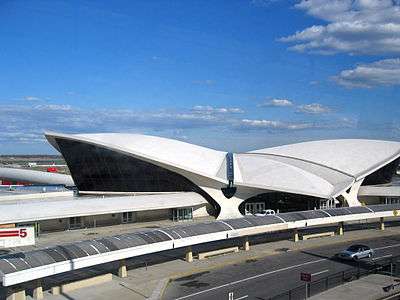Eero Saarinen
| Eero Saarinen | |
|---|---|
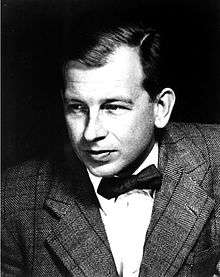 Eero Saarinen | |
| Born |
August 20, 1910 Kirkkonummi, Grand Duchy of Finland |
| Died |
September 1, 1961 (aged 51) Ann Arbor, Michigan, U.S. |
| Nationality | Finnish, American |
| Occupation | Architect |
| Awards | AIA Gold Medal (1962) |
| Buildings | See list of works |
| Design |
Gateway Arch Washington Dulles International Airport TWA Flight Center Tulip chair |
Eero Saarinen (Finnish pronunciation: [ˈeːro ˈsɑːrinen]) (August 20, 1910 – September 1, 1961) was a 20th-century Finnish American architect and industrial designer noted for his neofuturistic style.[1]
Biography
Eero Saarinen, the son of influential Finnish architect Eliel Saarinen and his second wife, Louise, was born on his father's 37th birthday, August 20, 1910.[2] They emigrated to the United States in 1923, when Eero was thirteen.[2] He grew up in Bloomfield Hills, Michigan, where his father taught and was dean of the Cranbrook Academy of Art, and he took courses in sculpture and furniture design there. He had a close relationship with fellow students Charles and Ray Eames, and became good friends with Florence Knoll (née Schust).
Beginning in September 1929, he studied sculpture at the Académie de la Grande Chaumière in Paris, France.[1] He then went on to study at the Yale School of Architecture, completing his studies in 1934.[3] Subsequently, he toured Europe and North Africa for a year and returned for a year to his native Finland, after which he returned to Cranbrook to work for his father and teach at the academy. He became a naturalized citizen of the United States in 1940. Saarinen was recruited by Donal McLaughlin, an architectural school friend from his Yale days, to join the military service in the Office of Strategic Services (OSS). Saarinen was assigned to draw illustrations for bomb disassembly manuals and to provide designs for the Situation Room in the White House.[4] Saarinen worked full-time for the OSS until 1944.[1] After his father's death in 1950, Saarinen founded his own architect's office, "Eero Saarinen and Associates". Eero Saarinen died of a brain tumor in 1961 at the age of 51.
Personal life
Saarinen had two children, Eric and Susan, from his marriage to sculptor Lilian Swann Saarinen, whom he married in 1939. Following their divorce in 1953, he married Aline Bernstein Louchheim (March 25, 1914 – July 13, 1972), an art critic at The New York Times, in 1954. They had a son, Eames, named after Saarinen's collaborator Charles Eames.
Work
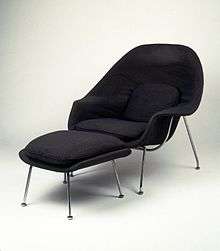
Saarinen first received critical recognition, while still working for his father, for a chair designed together with Charles Eames for the "Organic Design in Home Furnishings" competition in 1940, for which they received first prize. The "Tulip Chair", like all other Saarinen chairs, was taken into production by the Knoll furniture company, founded by Hans Knoll, who married Saarinen family friend Florence (Schust) Knoll. Further attention came also while Saarinen was still working for his father, when he took first prize in the 1948 competition for the design of the Jefferson National Expansion Memorial, St. Louis, not completed until the 1960s. The competition award was mistakenly sent to his father.
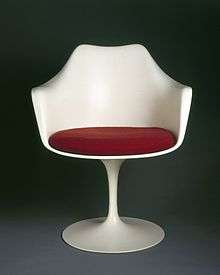
During his long association with Knoll he designed many important pieces of furniture including the "Grasshopper" lounge chair and ottoman (1946), the "Womb" chair and ottoman (1948),[5] the "Womb" settee (1950), side and arm chairs (1948–1950), and his most famous "Tulip" or "Pedestal" group (1956), which featured side and arm chairs, dining, coffee and side tables, as well as a stool. All of these designs were highly successful except for the "Grasshopper" lounge chair, which, although in production through 1965, was not a big success.

One of Saarinen's earliest works to receive international acclaim is the Crow Island School in Winnetka, Illinois (1940). The first major work by Saarinen, in collaboration with his father, was the General Motors Technical Center in Warren, Michigan. It follows the rationalist design Miesian style: incorporating steel and glass, but with the added accent of panels in two shades of blue. The GM Technical Center was constructed in 1956, with Saarinen using models. These models allowed him to share his ideas with others, and gather input from other professionals. With the success of the scheme, Saarinen was then invited by other major American corporations such as John Deere, IBM, and CBS to design their new headquarters. Despite their rationality, however, the interiors usually contained more dramatic sweeping staircases, as well as furniture designed by Saarinen, such as the Pedestal Series. In the 1950s he began to receive more commissions from American universities for campus designs and individual buildings; these include the Noyes dormitory at Vassar, Hill College House at the University of Pennsylvania, as well as an ice rink, Ingalls Rink, Ezra Stiles & Morse Colleges at Yale University, the MIT Chapel and neighboring Kresge Auditorium at MIT and the University of Chicago Law School building and grounds.
He served on the jury for the Sydney Opera House commission and was crucial in the selection of the now internationally known design by Jørn Utzon. A jury which did not include Saarinen had discarded Utzon's design in the first round. Saarinen reviewed the discarded designs, recognized a quality in Utzon's design which had eluded the rest of the jury and ultimately assured the commission of Utzon.
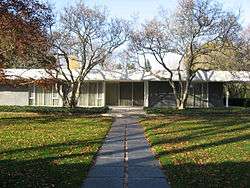
Eero Saarinen and Associates was Saarinen's architectural firm; he was the principal partner from 1950 until his death in 1961. The firm was initially known as "Saarinen, Swansen and Associates", headed by Eliel Saarinen and Robert Swansen from the late 1930s until Eliel's death in 1950. The firm was located in Bloomfield Hills, Michigan, until 1961 when the practice was moved to Hamden, Connecticut. Under Eero Saarinen, the firm carried out many of its most important works, including the Bell Labs Holmdel Complex in Holmdel Township, New Jersey, Jefferson National Expansion Memorial (including the Gateway Arch) in St. Louis, Missouri, the Miller House in Columbus, Indiana, the TWA Flight Center at John F. Kennedy International Airport that he worked on with Charles J. Parise, and the main terminal of Dulles International Airport near Washington, D.C.. Many of these projects use catenary curves in their structural designs.
One of the best-known thin-shell concrete structures in America is the Kresge Auditorium (MIT), which was designed by Saarinen. Another thin-shell structure that he created is Yale's Ingalls Rink, which has suspension cables connected to a single concrete backbone and is nicknamed "the whale". Undoubtedly, his most famous work is the TWA Flight Center, which represents the culmination of his previous designs and demonstrates his neofuturistic expressionism and the technical marvel in concrete shells.[1]
Eero worked with his father, mother and sister designing elements of the Cranbrook campus in Bloomfield Hills, Michigan, including the Cranbrook School, Kingswood School, the Cranbrook Art Academy and the Cranbrook Science Institute. Eero's leaded glass designs are a prominent feature of these buildings throughout the campus.
Death
Saarinen died in Ann Arbor, Michigan while overseeing the completion of a new music building for the University of Michigan School of Music, Theatre & Dance. He died while undergoing an operation for a brain tumor at the age of 51. His wife Aline, coincidentally, would die of the same ailment. His partners, Kevin Roche and John Dinkeloo, completed his ten remaining projects, including the St. Louis Arch.
Reputation
Eero Saarinen was elected a Fellow of the American Institute of Architects in 1952. He is also a winner of the AIA Gold Medal in 1962.
Saarinen is now considered one of the masters of American 20th-century architecture.[1] There has been a surge of interest in Saarinen's work in recent years, including a major exhibition and several books. This is partly because the Roche and Dinkeloo office has donated its Saarinen archives to Yale University, but also because Saarinen's oeuvre can be said to fit in with present-day concerns about pluralism of styles. He was criticized in his own time—most vociferously by Yale's Vincent Scully—for having no identifiable style; one explanation for this is that Saarinen adapted his neofuturistic vision to each individual client and project, which were never exactly the same.[1]
Legacy
In 1973, the Aline and Eero Saarinen papers[6] were donated to the Archives of American Art, Smithsonian Institution, by Charles Alan, Aline Saarinen's brother and executor of her estate. In 2006, the bulk of these primary source documents on the couple were digitized and posted online on the Archives' website.
An exhibition of Saarinen's work, Eero Saarinen: Shaping the Future, was organized by the Finnish Cultural Institute in New York in collaboration with Yale School of Architecture, the National Building Museum, and the Museum of Finnish Architecture. The exhibition toured in Europe and the US from 2006 to 2010.[7] From May to August 2008, the exhibit was at the National Building Museum in Washington, DC.[8] The exhibition was accompanied by the book Eero Saarinen. Shaping the Future.[1]
See also
References and further reading
- A&E with Richard Guy Wilson, Ph.D.,(2000). America's Castles: Newspaper Moguls, Pittock Mansion, Cranbrook House & Gardens, The American Swedish Institute. A&E Television Network.
- Roman, Antonio (2003). Eero Saarinen. New York: Princeton Architectural Press. ISBN 1-56898-340-9.
- Santala, Susanna (2015). Laboratory for a New Architecture: Airport Terminal, Eero Saarinen and the Historiography of Modern Architecture (Ph.D. thesis). Helsinki: University of Helsinki. ISBN 978-951-51-0993-4.
- Serraino, Pierluigi (2006). Saarinen, 1910–1961: a Structural Expressionist. Köln: Taschen. ISBN 3-8228-3645-1.
- Merkel, Jayne (2005). Eero Saarinen. London: Phaidon Press. ISBN 0-7148-4277-X.
- Pelkonen, Eeva-Liisa (2006). Eero Saarinen. New Haven: Yale University Press. ISBN 0-300-11282-3.
- Saarinen, Aline B. (ed) (1968). Eero Saarinen on His Work. New Haven: Yale University Press.
- Knight, Richard (2008). Saarinen’s Quest, A Memoir. San Francisco: William Stout Publishers. ISBN 978-0-9746214-4-9.
Notes
- 1 2 3 4 5 6 7 Eeva-Liisa Pelkonen and Donald Albrecht (eds), Eero Saarinen. Shaping the Future (2006)
- 1 2 "Eero Saarinen" (in Finnish). Museum of Finnish Architecture. See also "Eliel Saarinen" (in Finnish). Museum of Finnish Architecture.
- ↑ http://www.eero-saarinen-architect.com/
- ↑ Marefat, Mina (October 25, 2010). "REVEALED: EERO SAARINEN'S SECRET WARTIME ROLE IN THE WHITE HOUSE". Architectural Review. Retrieved 2014-08-16. (paywall)
- ↑ Your Guide to Vintage Danish Mid Century Modern Furniture Designers.
- ↑ Aline and Eero Saarinen papers.
- ↑ Eero Saarinen: Shaping the Future The 50th Anniversary Exhibition of the Museum of Finnish Architecture
- ↑ Eero Saarinen: Shaping the Future - National Building Museum
External links
| Wikimedia Commons has media related to Eero Saarinen. |
- Eero Saarinen letter to Florence Knoll Bassett, 1935–1936, Florence Knoll Bassett papers, Archives of American Art, Smithsonian Institution.
- Trans World Airlines Unit Terminal Building, New York International Airport, architectural drawings, 1958-1961Held by the Department of Drawings & Archives,Avery Architectural & Fine Arts Library, Columbia University
- Lines of Authority Time Magazine retrospective article
- Eero Saarinen – Design Dictionary Illustrated article about Eero Saarinen
- Saarinen rising: A much-maligned modernist finally gets his due
- Earl V. Moore Building School building designed by Eero Saarinen
- 860 photos of 19 buildings designed by Saarinen from the Balthazar Korab Collection at the Library of Congress
- Saarinen's Village: The Concordia Campus Through Time
- Digital image database at the Yale University Library, contains 1296 images and drawings from Saarinen's archives
- Finding aid to the Eero Saarinen Collection at Manuscripts and Archives, Yale University Library
- Saarinen Tulip Chair
- Eero Saarinen: Realizing American Utopia
- Eero Saarinen Exhibitions at Cranbrook Art Museum
- Eero Saarinen: Shaping Community from Blueprints, Winter 2007-08
